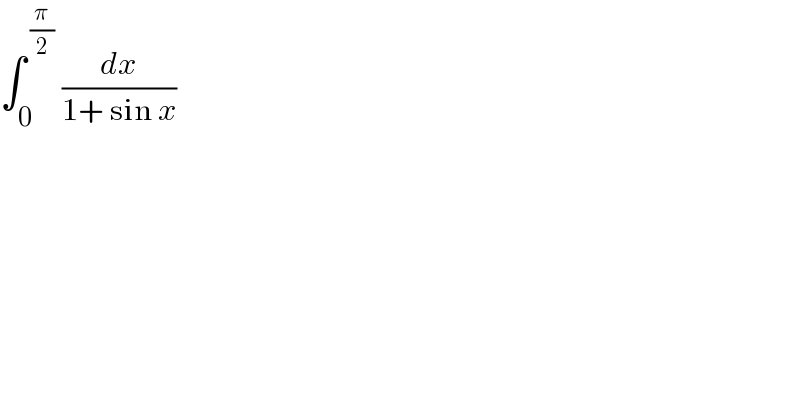Question Number 191519 by Acem last updated on 25/Apr/23

$$\int_{\mathrm{0}} ^{\:\frac{\pi}{\mathrm{2}}} \:\frac{{dx}}{\mathrm{1}+\:\mathrm{sin}\:{x}} \\ $$
Answered by BaliramKumar last updated on 25/Apr/23
![((1(1−sinx))/((1+sinx)(1−sinx))) = ((1−sinx)/(cos^2 x)) ∫_0 ^(π/2) (sec^2 x − secx∙tanx)dx = [tanx − secx]_0 ^(π/2) = 1 Answer ∫_0 ^(π/2) ((sec^2 (x/2))/((1+tan(x/2))^2 ))dx = ∫_1 ^2 (2/t^2 )dt = 2[((−1)/t)]_1 ^2 −2[(1/2)−1] = −2(((−1)/2)) = 1 Answer (1/(1+sinx)) = (1/(1+cos((π/2)−x))) = (1/(2cos^2 ((π/4)−(x/2)))) = (1/2)∫_0 ^(π/2) sec^2 ((π/4)−(x/2))dx = (1/2)[((tan((π/4)−(x/2)))/(−(1/2)))]_0 ^(π/2) =−[tan((π/4)−(x/2))]_0 ^(π/2) = −[tan0−tan(π/4)] = 1 Answer](https://www.tinkutara.com/question/Q191523.png)
$$\frac{\mathrm{1}\left(\mathrm{1}−\mathrm{sinx}\right)}{\left(\mathrm{1}+\mathrm{sinx}\right)\left(\mathrm{1}−\mathrm{sinx}\right)}\:=\:\frac{\mathrm{1}−\mathrm{sinx}}{\mathrm{cos}^{\mathrm{2}} \mathrm{x}} \\ $$$$\int_{\mathrm{0}} ^{\frac{\pi}{\mathrm{2}}} \left(\mathrm{sec}^{\mathrm{2}} \mathrm{x}\:−\:\mathrm{secx}\centerdot\mathrm{tanx}\right)\mathrm{dx}\:= \\ $$$$\:\left[\mathrm{tanx}\:−\:\mathrm{secx}\right]_{\mathrm{0}} ^{\frac{\pi}{\mathrm{2}}} \:=\:\mathrm{1}\:\mathrm{Answer} \\ $$$$ \\ $$$$\int_{\mathrm{0}} ^{\frac{\pi}{\mathrm{2}}} \frac{\mathrm{sec}^{\mathrm{2}} \frac{\mathrm{x}}{\mathrm{2}}}{\left(\mathrm{1}+\mathrm{tan}\frac{\mathrm{x}}{\mathrm{2}}\right)^{\mathrm{2}} }\mathrm{dx}\:=\:\int_{\mathrm{1}} ^{\mathrm{2}} \frac{\mathrm{2}}{\mathrm{t}^{\mathrm{2}} }\mathrm{dt}\:=\:\mathrm{2}\left[\frac{−\mathrm{1}}{\mathrm{t}}\right]_{\mathrm{1}} ^{\mathrm{2}} \\ $$$$−\mathrm{2}\left[\frac{\mathrm{1}}{\mathrm{2}}−\mathrm{1}\right]\:=\:−\mathrm{2}\left(\frac{−\mathrm{1}}{\mathrm{2}}\right)\:=\:\mathrm{1}\:\mathrm{Answer} \\ $$$$ \\ $$$$ \\ $$$$\frac{\mathrm{1}}{\mathrm{1}+\mathrm{sinx}}\:=\:\frac{\mathrm{1}}{\mathrm{1}+\mathrm{cos}\left(\frac{\pi}{\mathrm{2}}−\mathrm{x}\right)}\:=\:\frac{\mathrm{1}}{\mathrm{2cos}^{\mathrm{2}} \left(\frac{\pi}{\mathrm{4}}−\frac{\mathrm{x}}{\mathrm{2}}\right)} \\ $$$$=\:\frac{\mathrm{1}}{\mathrm{2}}\int_{\mathrm{0}} ^{\frac{\pi}{\mathrm{2}}} \mathrm{sec}^{\mathrm{2}} \left(\frac{\pi}{\mathrm{4}}−\frac{\mathrm{x}}{\mathrm{2}}\right)\mathrm{dx}\:=\:\frac{\mathrm{1}}{\mathrm{2}}\left[\frac{\mathrm{tan}\left(\frac{\pi}{\mathrm{4}}−\frac{\mathrm{x}}{\mathrm{2}}\right)}{−\frac{\mathrm{1}}{\mathrm{2}}}\right]_{\mathrm{0}} ^{\frac{\pi}{\mathrm{2}}} \\ $$$$=−\left[\mathrm{tan}\left(\frac{\pi}{\mathrm{4}}−\frac{\mathrm{x}}{\mathrm{2}}\right)\right]_{\mathrm{0}} ^{\frac{\pi}{\mathrm{2}}} \:=\:−\left[\mathrm{tan0}−\mathrm{tan}\frac{\pi}{\mathrm{4}}\right]\:=\:\mathrm{1}\:\mathrm{Answer} \\ $$
